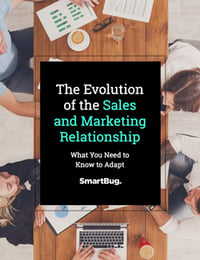
5 Ways Sales Enablement Encourages Marketing and Sales Alignment
October 23, 2019
By Eleni Hagen
Guest author Eleni Hagen is a content strategist for Highspot.
Although their methods may differ, marketers and sellers have at least one goal in common: to help their business grow. Yet despite this shared motivation, tensions occasionally arise between the two teams when it comes to deciding how best to achieve this growth. This misalignment between marketing and sales is important to address as soon as possible. If left unresolved, it can cost both teams time and effort—and can even cut into your bottom line.
Fortunately, a number of solutions exist to ease these interdepartmental pain points by streamlining processes, facilitating open communication, and fostering an environment of mutual understanding and respect. One such solution would be to implement a sales enablement program, which can serve as a powerful tool in creating a fruitful marketing and sales alignment strategy.
Read on for a look at how sales enablement provides answers to five typical frustrations that often plague both marketing and sales teams, as well as some thoughts on how sales enablement can ultimately helps reps and marketers work together in perfect harmony.
1. Sales Enablement Technology Organizes Content so that Marketers and Sellers Can Find It When They Need It
Marketing and sales teams that make do with a variety of ad hoc content repositories face a constant struggle when it comes to cataloging and locating assets. When marketers and sellers have to search through multiple silos for a single piece of sales material, they use time and energy they could have spent engaging buyers. These inefficiencies add up and can impact revenue.
Sales enablement can end this struggle once and for all. A comprehensive sales enablement solution gathers all of your content into one centralized, organized location, making endless searching a thing of the past. With a user-friendly enablement platform that seamlessly integrates with various marketing and sales systems, neither marketers nor sellers will ever have to go on a wild goose chase for content ever again.
As Forbes noted in a recent feature on sales enablement, “By integrating as many sales-related portals and platforms as possible, salespeople no longer need to look in multiple places for the content they need … It is all right at their fingertips, allowing them to jump easily from instructional materials like playbooks and scripts to consumer-facing content.”
2. Sales Enablement Empowers Marketers to Alert Reps About which Content Is the Most Up to Date
Without a unified program for interdepartmental communication, it can be difficult for marketers to keep sales reps in the loop and vice versa. Group emails frequently leave too much room for misinterpretation and don’t provide a sufficient platform for developing a meaningful dialogue between marketing and sales teams. Plus, it can be challenging to keep track of different versions of the same piece of content. At best, sales will be left feeling a little confused—at worst, they may end up using outdated content in their sales pitches, thereby putting deals at risk.
When new campaigns launch or messaging schematics shift, it helps to have a foolproof infrastructure that notifies reps of these updates in real time. Enter sales enablement. With a robust sales enablement solution, sellers receive in-context notifications whenever marketers update an asset or revise a pitch deck. These updates provide reminders to sales reps to use the latest and greatest marketing collateral in their next sales presentation, so sellers always have the most up-to-date content when and where they need it.
3. Once Content Goes Live, Sales Enablement Helps Marketers Gauge How It’s Helping Sellers
Sales enablement takes all the anxiety out of releasing content into the real world. Cutting-edge sales enablement solutions come with in-depth analytics that reveal how content performs with sellers. By leveraging analytics, marketers can track sales activity from content awareness to content coverage to pitch progress and beyond. Instead of hoping for the best, marketers will be able to gather real, actionable data on how sellers uncover and utilize the assets created by the marketing team.
4. Sales Enablement Also Helps Marketers and Sellers Gather Feedback on How Content Performs with Buyers
It can be incredibly tricky to measure buyer-to-content engagement without a system of analytics or a method for tracking buyer interactions with sales materials. Sales enablement can provide an elegant solution to this challenge.
An essential component of sales enablement is its capacity for closed-loop analytics—invaluable metric data that monitors buyer engagement from the first outreach email to the final signature on a closed deal. Marketers and sellers that employ closed-loop analytics gain detailed insight into how buyers interact with content.
This means both teams will be able to stay in the know regarding asset performance and content effectiveness, thanks to crucial metrics such as emails opened, digital presentations viewed, and pages scrolled. Certain sales enablement platforms can even translate buyer engagement into a precise dollar figure, providing marketers and reps with a definitive market value for every piece of content in their arsenal.
5. Sales Enablement Ensures that Content Remains on Brand
Multi-siloed content strategies can make it difficult to ensure alignment between marketing and sales teams. This goes double for ensuring brand alignment. When assets live in several different homes, sellers naturally have trouble finding the right content at the right moment. Rather than waste their time searching for what they need, reps may instead choose to modify presentational material to suit their sales purposes. This practice may make sense in terms of expediency, but it can result in content that’s not brand compliant.
Here again, sales enablement has the power to save the day. By offering sellers the ability to remix content directly within the platform, sales enablement lets reps change materials on the fly using only pre-approved content, and allows marketers to maintain visibility into every iteration of each asset. From here, the marketing team can also use analytics to gain a more informative perspective on how sellers are customizing content, which will give marketers helpful hints for optimizing and improving assets in the future.
When day-to-day annoyances stand in the way of a healthy relationship between sales and marketing, sales enablement can help you lay a solid foundation for complete alignment between the two teams. With its ability to combine content repositories, highlight content revisions for sales reps, generate content performance metrics for both marketers and sellers, and help assure brand compliance, sales enablement may very well be your strongest tool in promoting sales and marketing alignment. And when sales and marketing are properly aligned and enjoying a positive interdepartmental culture, everybody—from marketer to seller to buyer—benefits.

About the author
Eleni Hagen Eleni Hagen is a content strategist for Highspot, the industry’s most advanced sales enablement platform which helps organizations close the loop across marketing, sales, and customers. Read more articles by Eleni Hagen.









